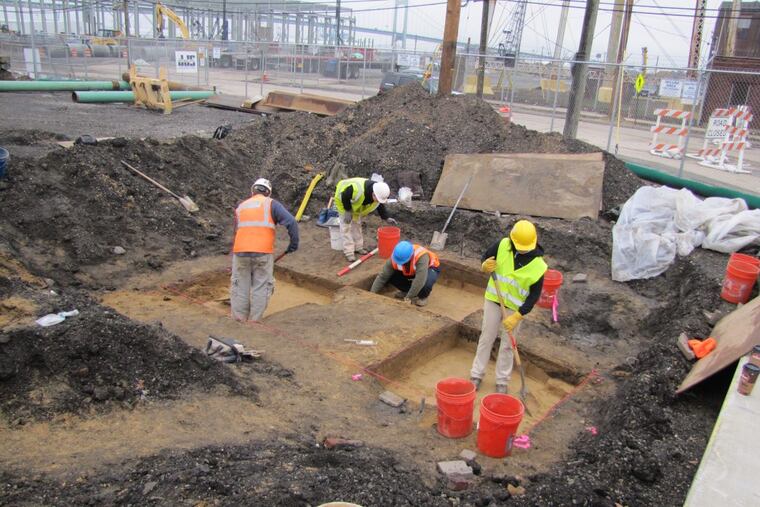Thousands of Native American artifacts unearthed in Camden archaeological dig
Some historians and archaeologists believe that evidence of early Native American activities and settlements have been largely obliterated in urban areas by centuries of development. But recent excavations in Camden suggest otherwise.

Nearly 10,000 Native American artifacts — a rectangular ceramic vessel, tool fragments, arrowheads, and other projectile points — have been discovered at two archaeological excavation sites in Camden.
Along with the hearthstones, animal bones, and remains of plants likely used for food, medicine, and fuel found during the excavations, the materials may shed light on the lives of indigenous people who camped along the Delaware River as early as 4,000 years ago.
Some of the objects will be donated to and displayed by the Camden County Historical Society museum in Camden.
"It's mind-blowing," executive director Jack O'Byrne said Tuesday. "We haven't gotten into the archaeology business before. It's our intention to look for grants or partner with a university."
But while artifacts "are really cool," the diggers found more than just artifacts, said Ilene Grossman-Bailey, senior archaeologist on the project.
"The intact remains of Native American activity on the site can help us understand what people were actually doing when they were there," she said.
Grossman-Bailey works for RGA Inc. of Cranbury, Middlesex County, the firm hired by Camden County and Holtec International to conduct the two excavations in 2015 and 2016. The state required archaeological studies because the construction of the Holtec International campus at the former New York Shipbuilding Co. site impacted wetlands.
After studying vintage maps as well as the results of test borings to determine the most likely locations of ground undisturbed by industrial or other activity, a team of archaeologists worked for months with hand tools to locate, document, and collect artifacts, which they transported back to RGA.
Grossman-Bailey said about a half-acre of vacant land north of Morgan Boulevard and east of Broadway most recently occupied by rowhouses was excavated to a depth of one to two feet.
The site yielded 1,292 artifacts, including the ceramic vessel likely used for cooking, and a hearth containing charcoal that later tests suggested dates from 1400 B.C. "We think we have evidence of just one short-term occupation," Grossman-Bailey said.
But a single acre of ground north of the Newton Creek and west of Broadway — on the former shipyard, now Holtec property — was excavated to a depth of between two to five feet, and was a wider and older window into the past.
Residue found on artifacts such as grinding stones and hammer stones used to prepare food suggest that people on the site consumed maize, legumes, and barley/wild rye. And burned animal bones, as well as protein residue found on one tool, suggested that people at the site at some point hunted, as well as gathered, food, said Grossman-Bailey.
Evidence for what she also described as "the processing and cooking of deer and other mammals, turtles, and wild fowl" also was found among the 7,458 artifacts.
These included 100 ceramic fragments and 11 "prehistoric features, including an enigmatic ditch/structural feature" that was "20 feet long, three feet wide and chock full of artifacts," Grossman-Bailey said.
"We don't really know what it is. There really isn't anything else like it in New Jersey, although similar features have been found near the Chesapeake and in New England," she added. "It could represent the remains of a structure. It almost suggests you might have the remains of a house."
The presence on the site of features made by human beings suggests that what may have begun as a temporary encampment grew into something larger and more permanent.
"We seem to have a variety of things going on there, and different periods represented, based on radiocarbon dating and the artifacts," Grossman-Bailey said.
"As time went on, something a bit more complex, maybe with people staying there longer, maybe living there year-round … may have occurred."
Aside from a smattering of "Indian towns" on early maps made by European arrivals, little evidence has been found to suggest substantial settlements of Native Americans existed in what is now South Jersey, at least in the late 17th century.
"We do know of transient settlements that reflected the seasonal food ways of Native Americans," said Paul Schopp, assistant director of the South Jersey Culture and History Center at Stockton University.
Grossman-Bailey, who earned a Ph.D. in anthropology at Temple and lives in Morrisville, said she has long been interested in the history of Camden, where her father was born and her grandfather owned a furniture store.
And she said perhaps the greatest significance of the findings may be the suggestion that more such sites, as yet undiscovered, may lie beneath the city,